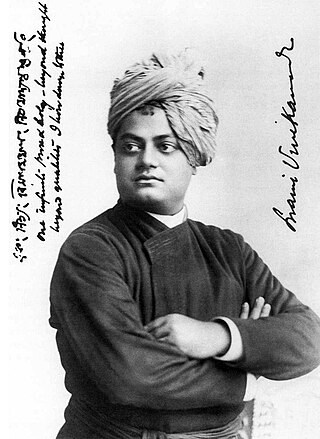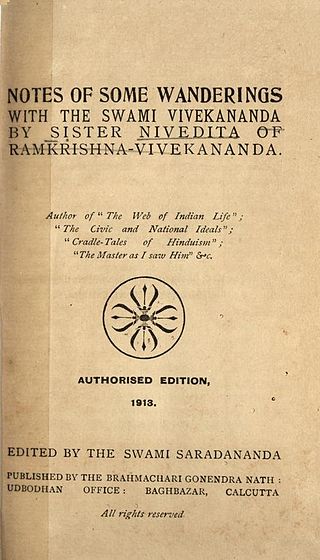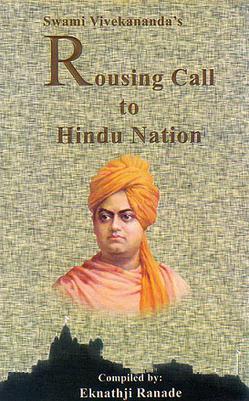Myths of the Hindus & Buddhists (1913) is a book written by Sister Nivedita and Ananda K. Coomaraswamy. [1]
Myths of the Hindus & Buddhists (1913) is a book written by Sister Nivedita and Ananda K. Coomaraswamy. [1]
Responding to the call of Swami Vivekananda, Sister Nivedita travelled to India in 1898. Josephine MacLeod, a friend and devotee of Swami Vivekananda, asked him how best she could help him and got the reply to "Love India". [2] Nivedita wrote multiple books on Indian history, culture, Vedic religion, Hinduism, Buddhism, etc.
In this book the author included and narrated some myths and stories from ancient Hindu and Buddhist literature. The book includes a good number of water colour illustrations which were created under the supervision of Abanindranath Tagore. Tagore himself drew some of the pictures in the book.
The myths and stories of this book include–

Swami Vivekananda, born Narendranath Datta was an Indian Hindu monk, philosopher, author, religious teacher, and the chief disciple of the Indian mystic Ramakrishna. He was a key figure in the introduction of Vedanta and Yoga to the Western world. He is credited with raising interfaith awareness and bringing Hinduism to the status of a major world religion in the late nineteenth century.
Contemporary groups, collectively termed Hindu reform movements, reform Hinduism, neo-Hinduism, or Hindu revivalism, strive to introduce regeneration and reform to Hinduism, both in a religious or spiritual and in a societal sense. The movements started appearing during the Bengali Renaissance.

Belur Math is the headquarters of the Ramakrishna Math and Ramakrishna Mission, founded by Swami Vivekananda, the chief disciple of Ramakrishna Paramahamsa. It is located in Belur, West Bengal, India on the west bank of Hooghly River. Belur Math was established in January 1897, by Swami Vivekananda who was the disciple of Sri Ramakrishna. Swami Vivekananda returned to India from Colombo with a small group of disciples and started work on the two one at Belur, and the others at Mayavati, Almora, Himalayas called the Advaita Ashrama. The temple is the heart of the Ramakrishna movement. It is notable for its architecture that fuses Hindu, Islamic, Buddhist, and Christian art and motifs as a symbol of unity of all religions. In 2003, Belur Math railway station was also inaugurated which is dedicated to Belur Math Temple.

Sister Nivedita was an Irish teacher, author, social activist, school founder and disciple of Swami Vivekananda. She spent her childhood and early youth in Ireland. She was engaged to marry a Welsh youth, but he died soon after their engagement.

Prabuddha Bharata Or Awakened India is an English-language monthly journal of the Ramakrishna Order, in publication since July 1896. It carries articles and translations by monks, scholars, and other writers on humanities and social sciences including religious, psychological, historical, and cultural themes. It has a section of book reviews where important publications from university presses from around the world are reviewed. It is edited from Advaita Ashrama, Mayavati, Uttarakhand, and published and printed in Kolkata. Prabuddha Bharata is India's longest running English journal.

Sister Gargi, born Marie Louise Burke, was a writer and an eminent researcher on Swami Vivekananda, and a leading literary figure of the Ramakrishna-Vivekananda movement. Gargi was introduced to the Ramakrishna-Vivekananda movement in 1948 by Swami Ashokananda. She is known for her six-volume work, Swami Vivekananda in the West: New Discoveries. Her New Discoveries are considered as indispensable for Swami Vivekananda research.

Amiya Prosad Sen is a historian with an interest in the intellectual and cultural history of modern India. Currently he is Sivadasani Fellow at the Oxford Centre for Hindu Studies, Oxford (UK). He was previously the Heinrich Zimmer Chair at the South Asia Institute, Heidelberg University. He has served as Professor of Modern Indian History at Jamia Millia Islamia, New Delhi. He has been Agatha Harrison Fellow to the University of Oxford and Visiting Fellow to the Indian Institute of Advanced Study, Shimla, and the Centre for Contemporary Studies, Nehru Memorial Museum & Library, New Delhi. During 2007–08, he was Tagore professor at Vishwa Bharati, Shantiniketan.

Josephine MacLeod was an American friend and devotee of Swami Vivekananda. She had a strong attachment to India and was an active participant in the Ramakrishna Vivekananda movement. She was given the nicknames "Tantine" and "Jo Jo" by Vivekananda. She considered Swami Vivekananda to be her friend and helped him with his finances. MacLeod was not a sanyasin, unlike many others such as Sister Nivedita or Sister Christine. She was instrumental in spreading Vivekananda's message on Vedanta in the West. She made many contributions to the initial and the later phases of the development of the order of Ramakrishna and Vivekananda. She was a contributor to many causes espoused by Sister Nivedita, the most famous disciple of Vivekananda, including that of contributing financially towards the development of the Indian National Movement especially in Bengal and elsewhere in India.

Cradle Tales of Hinduism (1907) is a collection of stories by Sister Nivedita. It is an introduction to Hindu mythology; the stories come from the Mahabharata, the Ramayana and other Hindu sources and are presented as they were told in Indian nurseries.

An Indian Study of Love and Death (1908) is a book written by Sister Nivedita.

Notes of Some Wanderings with the Swami Vivekananda (1913) is an English-language book written by Sister Nivedita. In this book Nivedita has narrated the experiences she had while traveling with Swami Vivekananda in different parts of India.

Select Essays of Sister Nivedita (1911) is an English-language book written by Sister Nivedita, a disciple of Swami Vivekananda. The foreword of the book was written by A. J. F. Blair.

Swami Vivekananda (1863–1902) was an Indian Hindu monk and a key figure in the introduction of Indian philosophies of Vedanta and Yoga to the western world. He was one of the most influential philosophers and social reformers in his contemporary India and the most successful and influential missionaries of Vedanta to the Western world. Indian Nobel laureate poet Rabindranath Tagore's suggested to study the works of Vivekananda to understand India. He also told, in Vivekananda there was nothing negative, but everything positive.

Swami Vivekananda represented India and Hinduism at the Parliament of the World's Religions (1893). India celebrates National Youth Day on the birth anniversary of the great Swami.

Neo-Vedanta, also called Hindu modernism, neo-Hinduism, Global Hinduism and Hindu Universalism, are terms to characterize interpretations of Hinduism that developed in the 19th century. The term "Neo-Vedanta" was coined by German Indologist Paul Hacker, in a pejorative way, to distinguish modern developments from "traditional" Advaita Vedanta.

Swami Vivekananda, the 19th-century Indian monk, came to Los Angeles, California in 1899 during his second visit to the West. His oratorical skills and presentation of Hindu religious tenets and comparison with other religious beliefs made him a celebrity among a wide spectrum of American audience. Between 1893—1897 and 1899–1902, he traveled widely in the US lecturing on a wide range of subjects and also established Vedanta Centers. There are such centers in many cities in the US, including many centers in California. In 1899, after delivering lectures in New York, he travelled to the western part of the United States and reached Los Angeles via Chicago. He then went on to deliver lectures in California at Oakland, San Francisco and Alameda.

Swami Vivekananda, the nineteenth-century Indian Hindu monk, is considered one of the most influential people of modern India and Hinduism. Rabindranath Tagore suggested to study Vivekananda's works to learn about India. Indian independence activist Subhas Chandra Bose regarded Vivekananda as his spiritual teacher. Mahatma Gandhi said that after reading the works of Vivekananda, his love for his nation became a thousand-fold.

Rousing Call to Hindu Nation or Swami Vivekananda's Rousing Call to Hindu Nation (1963) is a compilation of Indian Hindu monk Swami Vivekananda's writings and speeches edited by Eknath Ranade the leader of Rashtriya Swayamsevak Sangh. The book was published in 1963, in the birth centenary of Vivekananda. Ranade dedicated the book as a "personal homage to the great patriot-saint" Swami Vivekananda.
In 1888, Swami Vivekananda left the monastery as a Parivrâjaka— the Hindu religious life of a wandering monk, "without fixed abode, without ties, independent and strangers wherever they go". His sole possessions were a kamandalu, staff and his two favourite books: the Bhagavad Gita and The Imitation of Christ. Narendra travelled extensively in India for five years, visiting centres of learning and acquainting himself with diverse religious traditions and social patterns. He developed sympathy for the suffering and poverty of the people, and resolved to uplift the nation. Living primarily on bhiksha (alms), Swami Vivekananda travelled on foot and by railway. During his travels he met, and stayed with Indians from all religions and walks of life: scholars, dewans, rajas, Hindus, Muslims, Christians, paraiyars and government officials.

Christ, the Messenger was a lecture delivered by Swami Vivekananda in Los Angeles, California in January 1900. In the same year, the lecture was published as a book by The Vedanta Centre, Boston. In his lecture, Vivekananda attempted to analyze the life and messages of Jesus through Vedanta.